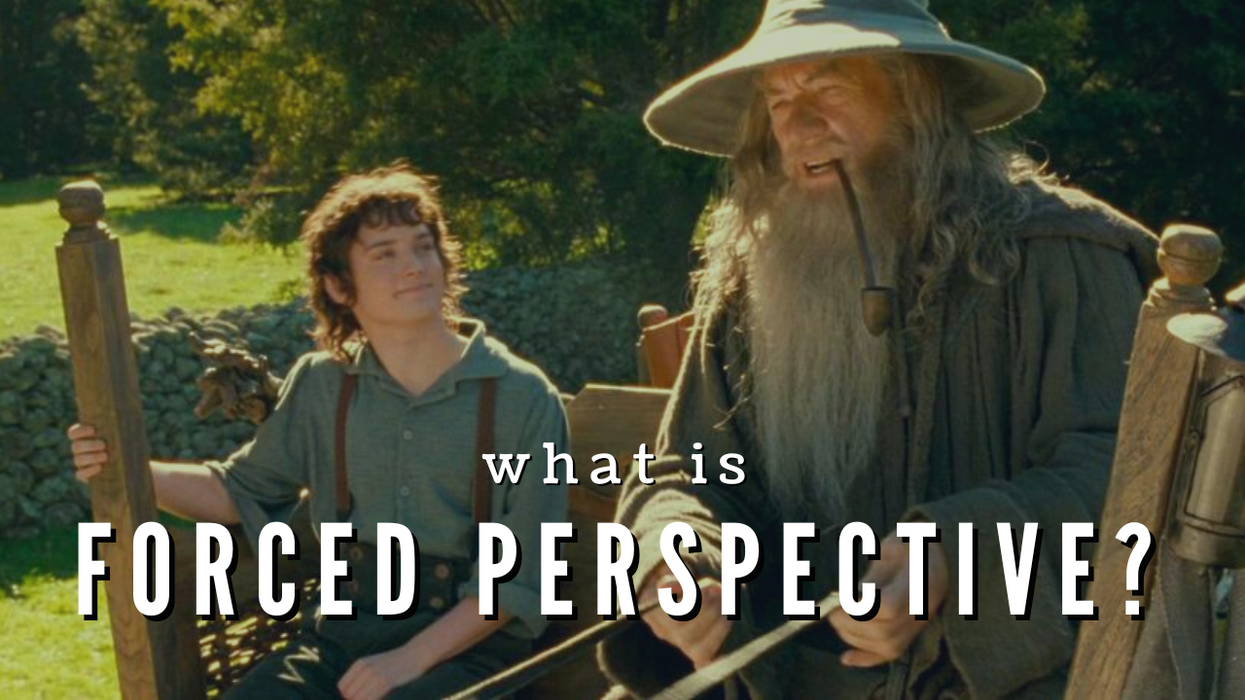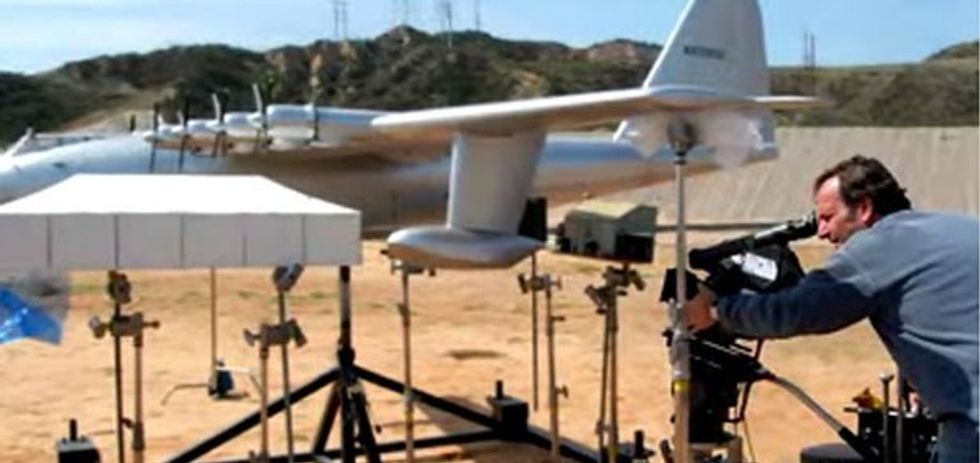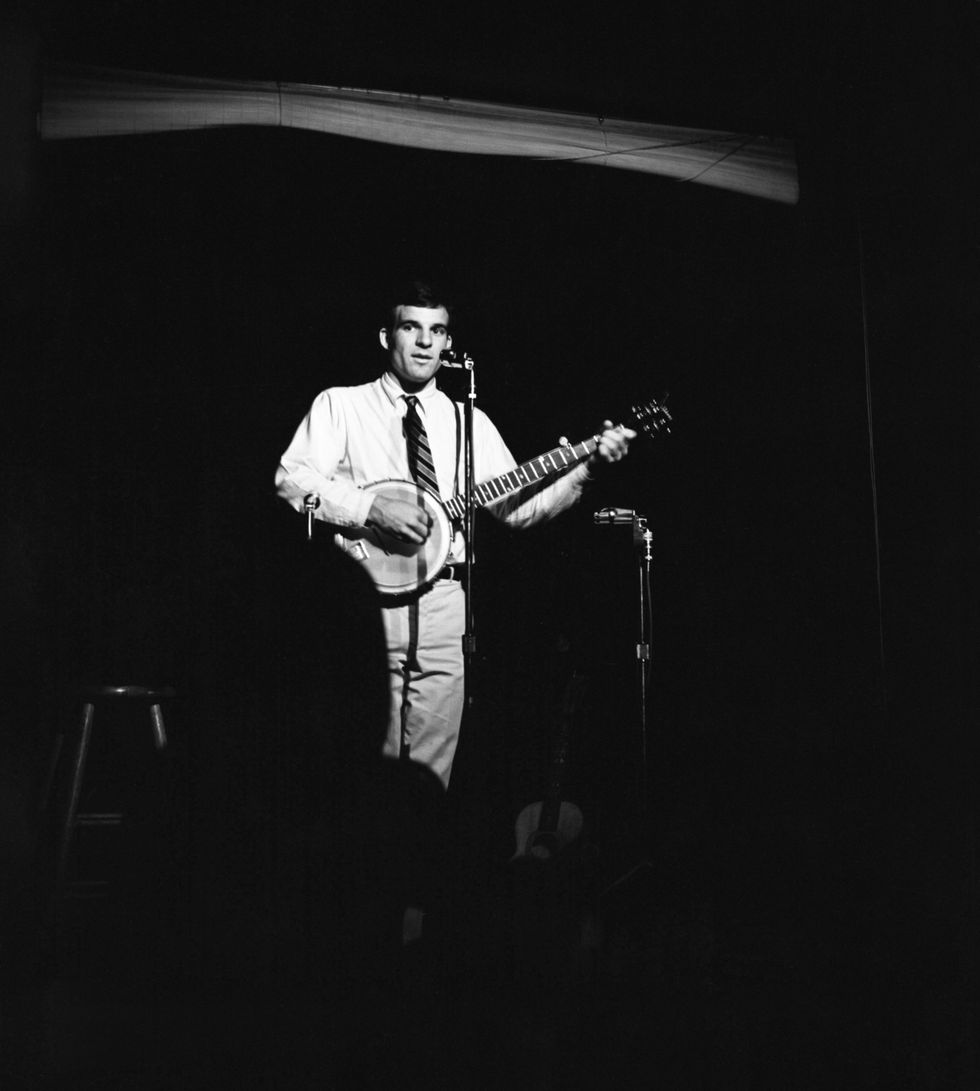What Is Forced Perspective Photography?
We go over the definition and examples of the artform.

One of the most fun camera tricks is forced perspective in film and TV. You can make characters taller, shorter, and even change the physics of the world you've built. This kind of camera angle allows you to change the way an audience feels and reacts. You can add to a performance and to the reality, and wow the people watching. But how do you shoot forced perspective photography? And what are some camera tricks used in movies like The Lord of the Rings that you can do at home?
Today, we'll go over the forced perspective definition, look at some examples, and see how these optical illusions are created. We'll even look at some things you can do to ensure your forced perspective photography looks as good as the pros. We'll get to the bottom of this optical illusion.
Ready? Let's dive in.

What Is Forced Perspective Photography in Film? (Definition and Examples)
What is forced perspective? Well, many great (and not-so-great) filmmakers have used this technique to create the illusion. B-movies from the 50s and 60s used this often, since it was a cheap alternative to constructing huge models and sets.
Some well-known films, like The Lord of the Rings and Harry Potter, used this technique to make characters look bigger and smaller (the Hobbits and Hagrid, respectively.) LOTR used forced perspective with a moving camera. So how do we define forced perspective?
Forced Perspective Definition
Forced perspective is a photography or filmmaking technique that uses the space between subjects to manipulate the viewer's perception of the space and distance between two objects, creating an optical illusion. This illusion makes the subject of the shot appear farther away, closer, larger, or smaller than it actually is.
The forced perspective photography definition is the same as the above, just done using a still camera instead of a movie camera.
Forced Perspective in Film
One of the most common ways we see forced perspective in film is with miniatures. In fact, for Close Encounters of the Third Kind, Steven Spielberg used a model ship in the Mojave Desert of California to double for the Gobi Desert of Mongolia. He placed the model close to the camera and used a wide lens with deep focus. It gave the appearance of a real tanker in the actual desert.

Forced Perspective Examples
Another one of my favorite forced perspective shots in film is from The Aviator. Obviously, it would be incredibly expensive to shoot with a ton of real planes. So they used miniatures to make it look like real planes were flying. In this shot of the Spruce Goose flying, Martin Scorsese wanted it to feel real. So they used a miniature and some forced perspective to give us the illusion of an actual plane soaring when it was really a model.

LOTR camera tricks
Of course, the movies that made their name on forced perspective was The Lord of the Rings franchise. Special and visual effects are great, but unless you're a skilled SFX artist or post-production magician, they tend to be pretty spendy. If you're gearing up to work on a film that calls for characters of varying sizes (or you're just really into The Lord of the Rings and Hobbits), there is an inexpensive alternative to CGI.
This tutorial by Ben Lucas of Tuts+ will show you one method the LOTR filmmakers used to make the towering wizard Gandalf look so much bigger than his little Hobbit friend Frodo—a practical effect that uses forced perspective to sell the illusion.
According to Lucas, LOTR used four different methods to create the "Hobbit-sized illusion"—compositing using green screens, big rigs, stunt doubles, and finally, forced perspective. If you're unfamiliar with this technique, it's essentially an optical illusion that makes things appear closer, farther, bigger, or smaller than they actually are—like all of the pictures tourists take of their buddies pushing over the Leaning Tower of Pisa.
One great thing about Lucas' video is that it not only shows you how to set up one of the most important parts of the forced perspective illusion, a split rig (two sets with different sized objects), but it also breaks down the mathematical equation that helps with staging your characters correctly. Lucas explains this further:
"The mechanics of this video are geared toward getting the 1:1.3 ratio that is specific to hobbits. However, if you are looking to create any smaller mythical people, figure out how small specifically you are trying to make them, and you can calculate the new camera to subject distances required. Half height? Multiply the human distance by .5 or the Hobbit distance by 1.5."
Check out the video below.
It takes a lot of skill to pull off forced perspective, so simply plopping your characters down on either end of a table isn't going to cut it. The split rig helps to sell the effect, but like the video illustrates, you have to pay close attention to eyeline, as well as your depth of field. It'd also be wise to be aware of lighting—making sure that it falls naturally on your scene, instead of giving away the illusion. Of course, there's more than one way to achieve this effect, but anything that can save both time and money is a definite boon to your production—not to mention the awesome feeling of pulling off practical effects!
Forced Perspective in Elf
Everyone has a favorite holiday go-to. For many, apparently, it’s now Die Hard. Here’s a whole infographic to prove how it is indeed a Christmas movie. But for others, the 2003 holiday comedy Elf (2003) starring Will Ferrell and Zooey Deschanel is a Christmas must-watch.
While the movie has aged surprisingly well for its era (2003 is not often considered a height of comedy filmmaking), it also gets a good boost this time every year for its sing-along scenes and Will Ferrell's fun-loving man-child antics.
However, as seen on Reddit and several other places, an appreciation for its practical effects has also suddenly popped up.

The Forced Perspective Used in Elf
As you can see in the images above, forced perspective was a go-to filmmaking trick for Jon Favreau and his team to create many of the shots early in the film where the oversized Buddy struggles to fit in with Santa's elf community. For those who have studied filmmaking, using forced perspective for shots like this shouldn't come as much of a surprise as we've already seen many examples of it over the years in films like The Lord of the Rings.
However, as simple as it seems, it is always impressive to see in action. It's hard to see for sure, but the top image above appears to come from this behind-the-scenes series on the making of Elf. You can watch part 1 here, but the scenes in the elf community are shown (briefly) in this part 2 video below as first assistant director Jim Brebner explains his role and some of the shots which they're trying to get.
How to Create Forced Perspective Photography
One big headache of making films on a tight budget is having to sacrifice parts of your story in order to keep the project from costing an arm and a leg. Sometimes that's just the nature of the beast and completely unavoidable, but other times, with a little help from some clever visual effects techniques, we can save money and keep what we want in our films.
Vashi Nedomansky of Vashi Visuals reminds us that, at its core, cinema is a medium of illusion. By setting a miniature Humvee in the sand dunes of California, he was able to use forced perspective to shoot a flashback scene with a realistic-looking vehicle set in the Iraqi desert in this forced perspective photo. Continue reading to find out how he did it.

Vashi mentioned that the project he was working on didn't have the budget to shoot with real Humvees in the desert. He said, "In this example, we were shooting on a Panasonic HVX-170 with a 1/3″ sensor at the widest lens setting, so depth of field was not an issue. I was at f/11 and everything from one foot to infinity was in focus. The Humvee was about 2 feet from the camera and the actors were 40 feet away."
Forced Perspective Ideas
Forced perspective is an optical illusion that makes things appear closer, farther, bigger, or smaller than they actually are. We've all seen photos of people pushing over the Leaning Tower of Pisa or squishing things in the distance with our fingers—that's forced perspective.
In order to find easy forced perspective photography opportunities, think about what you have on hand. Are there toys or locations that can be juxtaposed to give a new perspective? Something nearby you can use and an expansive backdrop if you position the camera just right? Experiment with your ideas and see what works!
If you're looking for more filmmaking inspiration or other cool practical effects to try on your own, check out some of these No Film School articles as well.
Summing Up Forced Perspective
After reading all that, I hope you have some forced perspective photo ideas and have a good idea of how to shoot some forced perspective photography at home. As you can see, filmmakers on various budgets use this technique to make sure their world looks real and unique.
If you're looking into cameras, check out our comparison between the BMPCC6K and the BMPCC4K!
Check out our guide to types of film lights, film lighting techniques, and of course, composition for beginners! If you are looking for advice from the masters, look no farther than Steven Spielberg's 10 filmmaking tips, or these 6 Coen brothers quotes to inspire your process!
Now get shooting!














